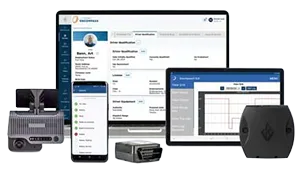CSA - Who Does It Affect?
Every company with a U.S. DOT number and operating in interstate commerce is affected by CSA and all intrastate carriers transporting placarded hazmat.
Operating in interstate commerce means the passengers or goods have traveled into or through another state or country, or that someone has gone into another state or country to perform a service. Even if the truck or bus does not leave the state, but the passengers or goods have or will as part of the trip, the transportation is considered to be in interstate commerce. Interstate commerce means the goods have left their home state or the person performing a service has left his or her home state. The Federal Motor Carrier Safety Administration (FMCSA) also has jurisdiction over intrastate hazmat carriers.
Motor carrier and driver safety performance are rated in seven different Behavioral Analysis Safety Improvement Categories (BASICs):
- Unsafe Driving – Refers to dangerous or careless operation of commercial motor vehicles (CMVs). Data includes driver traffic violations and convictions for speeding, reckless driving, improper lane change, inattention, and other unsafe driving behavior. (FMCSR Parts 392 and 397)
- Hours of Service Compliance – Driving CMVs when ill, fatigued, or in violation of the hours-of-service (HOS) rules. This is distinguished from incidents where unconsciousness or an inability to react is brought about by the use of alcohol, drugs, or other controlled substances. Data includes HOS violations discovered during an off-site investigation, on-site investigation, roadside inspection, or post-crash inspection and crash reports with driver fatigue as a contributing factor.
- Driver Fitness – Operation of a CMV by drivers who are unfit to operate a CMV due to lack of training, experience, or medical qualification. Data includes:
- Inspection violations for failure to have a valid and appropriate commercial driver's license or medical or training documentation,
- Crash reports citing a lack of experience or medical reason as a cause or contributory factor, and
- Violations from an off-site investigation or an on-site investigation for failure to maintain proper driver qualification files, or use of unqualified drivers. (FMCSR Parts 383 and 391)
- Controlled Substances and Alcohol - Operation of a CMV while impaired due to alcohol, illegal drugs, and misuse of prescription medications or over-the-counter medications. Data includes:
- Roadside violations involving controlled substances or alcohol,
- Crash reports citing driver impairment or intoxication as a cause,
- Positive drug or alcohol test results on drivers, and
- Lack of appropriate testing or other deficiencies in motor carrier controlled substances and alcohol testing programs. (FMCSR Part 392)
- Vehicle Maintenance – CMV failure due to improper or inadequate maintenance. Data includes:
- Roadside violations for brakes, lights, other mechanical defects, or cargo securement;
- Crash reports citing a mechanical failure or inadequate cargo securement as a contributing factor; or
- Violations from an off-site investigation or an on-site investigation associated with pre-trip inspections, maintenance records, and repair records
- Hazardous Materials Compliance – Unsafe marking, handling, or transportation of hazardous materials in an amount requiring a placard. Data includes:
- Roadside inspection violations pertaining to hazardous material transportation; and
- Crash reports citing HM violations as a cause or contributing factor
- Crash Indicator – Histories or patterns of high crash involvement, including frequency and severity. Data includes law enforcement crash reports and crashes reported by the carrier and discovered during on-site investigations. Fault and preventability are not taken into consideration unless the motor carrier undergoes an investigation.
Based on BASIC CSA scores, FMCSA determines what (if any) interventions are taken against the carrier based on predetermined thresholds.



